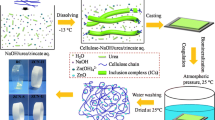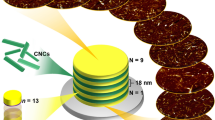Abstract
Zinc oxide (ZnO) nanoparticles were immobilized on the surface of regenerated cellulose films by a wet chemical method in which the controlled hydrolysis of a Zn(II)-amine complex leads to the formation of ZnO nanoparticles. Cellulose-ZnO materials were characterized by spectral, thermal and optical methods. Scanning electron microscope and atomic force microscope analyses confirmed the formation of ZnO nanoparticles on the surface of the regenerated cellulose film and X-ray diffraction patterns showed the ZnO had the wurtzite structure. The reported method is very simple, and can immobilize the nanoparticles without the aid of a binder or dendritic side group and without high temperature treatments like calcination. ZnO immobilized on biopolymers like cellulose has many potential applications such as strain sensors, biomedical sensors, flexible display devices and optoelectronics.








Similar content being viewed by others
References
Dahiya JB, Rana S (2004) Thermal degradation and morphological studies on cotton cellulose modified with various arylphosphorodichloridites. Polym Int 53:995–1002
El Seoud OA, Marson GA, Ciacco GT, Frollim E (2000) An efficient, one-pot acylation of cellulose under homogeneous reaction conditions. Macromol Chem Phys 201:882–889
Ghule K, Ghule AV, Chen B-J, Ling Y-L (2006) Preparation and characterization of ZnO nanoparticles coated paper and its antibacterial activity study. Green Chem 8:1034–1041
Goncalves G, Marques P, Neto CP, Trindade T, Peres M, Monteiro T (2009) Growth, structure, and optical characterization of ZnO-coated cellulosic fibers. Cryst Growth Des 9:386–390
Kim J, Yun S, Ounaies Z (2006) Discovery of cellulose as a smart material. Macromolecules 39:4202–4206
Klemm D, Heublein B, Fink H-P, Bohn A (2005) Cellulose: fascinating biopolymer and sustainable raw material. Angew Chem Int Ed 44:3358–3393
Mumalo-Djokic D, Stern WB, Taubert A (2008) Zinc oxide/carbohydrate hybrid materials via mineralization of starch and cellulose in the strongly hydrated ionic liquid tetrabutylammonium hydroxid. Cryst Growth Des 8:330–335
Pushparaj VL, Shaijumon MM, Kumar A, Murugesan S, Ci L, Vajtai R, Linhardt RJ, Nalamasu O, Ajayan PM (2007) Flexible energy storage devices based on nanocomposite paper. PNAS 104:13574–13577
Spantel L, Anderson MA (1991) Semiconductor clusters in the sol-gel process: quantized aggregation, gelation, and crystal growth in concentrated zinc oxide colloids. J Am Chem Soc 113:2826–2833
Vanheusden K, Warren WL, Seager CH, Tallant DR, Voigt JA (1996) Mechanisms behind green photoluminescence in ZnO phosphor powders. J Appl Phys 79:7983–7990
Acknowledgments
This work was supported by Inha University Research Grant.
Author information
Authors and Affiliations
Corresponding author
Rights and permissions
About this article
Cite this article
John, A., Ko, HU., Kim, DG. et al. Preparation of cellulose-ZnO hybrid films by a wet chemical method and their characterization. Cellulose 18, 675–680 (2011). https://doi.org/10.1007/s10570-011-9523-1
Received:
Accepted:
Published:
Issue Date:
DOI: https://doi.org/10.1007/s10570-011-9523-1




